Lesbian Art History in Europe 1850 – 1950
by Birthe Havmoeller
Introduction:
The term ‘lesbian artist’ meaning a ‘lesbian feminist artist’ was coined by the feminist movement of the 1970s. I use the term ‘lesbian artists’ as an umbrella term in this article, as a description of women artists who loved women and chose to follow their desires and get involved in romantic relationships with women rather than following the (heteronormative) European norm: to get married. The Greek poet Sappho’s association with erotic love between women dates to at least 1825 in writing in English, sparking the use of words like ‘sapphist’ and ‘sapphism’. The noun ‘lesbian’ was first recorded in the 1890 Billing’s Medical Dictionary. Around 1900 the terms ‘invert’, ’lesbian’, ‘homosexual’ and ‘homosexuality’ were to some extent interchangeable with ‘sapphist’ and ‘sapphism’. The ‘sapphists’ identified with Sappho (the Greek poet) i.e. they were leaders and members of an elite. The ‘lesbians’ were followers of the Sapphists, thus these terms describe the implicit class system of the homosexual community of the time in Europe. All the women worked in some way or another to create their versions of woman-centered communities through salons, all-woman dance groups, performances, personal networks, etc.
The informal networks of the lesbian artists in pre-1950 Europe and their loving relationship are likely to have influenced their creative practice; they were not equally explicit in their writings about the importance of their romantic partners and “wifes” as source of creative inspiration, guidance and moral or financial support, or their personal diaries have been lost to history. This article presents glimpses of their lives.
Rosa Bonheur (1822 – 1899)
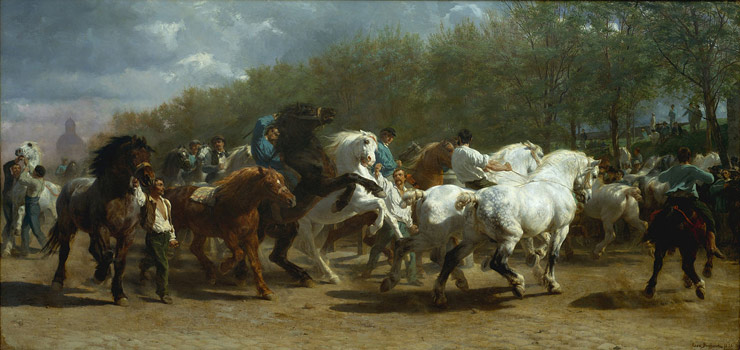
Horse Fair by Rosa Bonheur (created in 1852 – 1855). The scene is the horse market in Paris. The dome of La Salpêtrière is visible in the background.
French painter Rosa Bonheur (1822 – 1899) was both famous as an artist and as a lesbian in her life. She had an ardent love for horses, cute calves, dogs and other domesticated animals. A French government commission led to Rosa Bonheur’s first great success: Ploughing in the Nivernais, exhibited in 1849. Her most famous work, the monumental Horse Fair which measured 2.5 m high by 4.90 m wide was completed in 1855. Rosa wore men’s clothes when she worked with the animals who were her models. She lived in a relationship for 45 years with Nathalie Micas. After Nathalie’s death American artist Anna Elizabeth Klumpke became Rosa’s second wife and her biographer. The richly illustrated biography was published in 1909 as Rosa Bonheur: sa vie, son oeuvre.
Mary Lloyd (1819 – 1896)
Mary Lloyd (1819 – 1896) was a Welsh sculptor. In 1853 she was working in the studio of fellow Welsh sculptor John Gibson in Rome. She was a member of the international colony of artists in Rome along with artists such as American lesbian sculptor Harriet Hosmer. In 1859 Mary became financially independent after the death of her father and in the winter of 1861-62, she met Frances Power Cobbe, a writer and leading women’s suffrage campaigner. They fell in love and in 1863 they settled together in London. Soon after Mary ended her career as an artist. However, she is known to have been a lifelong friend of French artist Rosa Bonheur. Mary and France’s relationship lasted for 34 years until Mary’s death in 1896.
Louise Abbéma (1853 – 1927)
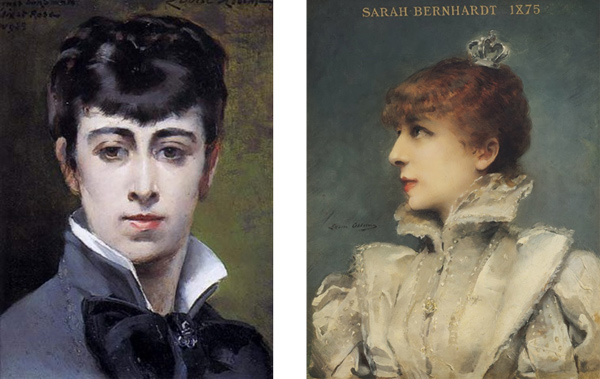
Self-portrait by Louise Abbéma (1876) and Sarah Bernhardt 1875 by Louise Abbéma (1875).
Louise Abbéma (1853 – 1927) was a French painter, sculptor and designer of the Belle Époque. She was born into a wealthy Parisian family, who were well connected with the local artistic community. Louise started painting at an early age and received the first recognition for her work at age 23 when she painted a portrait of famous French actress Sarah Bernhardt (in 1875), her lifelong friend and lover. Louise exhibited frequently at the Salon des Artistes Françai in Paris until 1926.
Ambrosia Tønnesen (1859 – 1948)
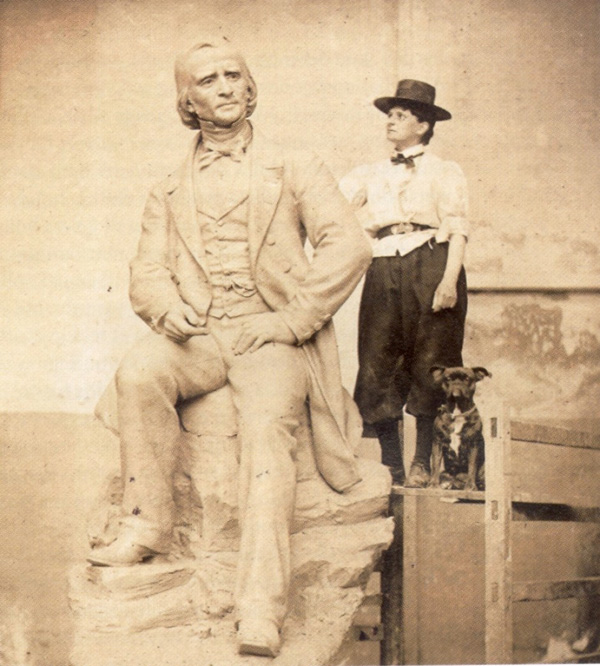
Ambrosia Tønnesen was wearing bloomers (popular cycle wear for women in the 1890s) when she worked in her studio.
Norwegian sculptor Ambrosia Tønnesen (1859 – 1948) studied art in Copenhagen, Denmark in 1884 and presented her first works at an exhibition in Bergen, Norway the same year. A year later she went to Berlin to continue her art studies and in 1887 she moved to Paris, where she studied and worked for more than 20 years. Ambrosia met her wife British Mary Banks in 1888 and they lived together for 30 years in Paris and in Bergen, Norway.
Sigrid Blomberg (1863 – 1941)
Sigrid Blomberg was a Swedish sculptor. She grew up in the countryside of the county of Småland in the south of Sweden and moved to Stockholm at the age of 21 to study art. She studied sculpture at the Stockholm Art Academy, and later she furthered her studies in Dresden, Germany. In 1890 she got an important assignment: an alter group sculpture for Oskarshamn’s church in Sweden. This led to more assignments, among others Bebådelsen (the Annunciation) which she had made in Italy for the Swedish State. She worked in Florence, Italy, for some years before she returned to Stockholm. Sigrid Blomberg worked in many materials. In the early years, she worked with wood only, later her choice of materials comprised of clay, plaster, marble, bronze and stone. She mainly produced works for public spaces and avoided displaying her art in exhibitions. There are probably several reasons for her reluctance, and today she is written out of Swedish art history. In 1904, Sigrid Blomberg built a summer residence in her Småland homeland where she worked for many years. Her life companion was the historian and author Sigrid Leijonhufvud.
Sapphism And The Male Artists’ Erotic Fantasies In The 19th Century
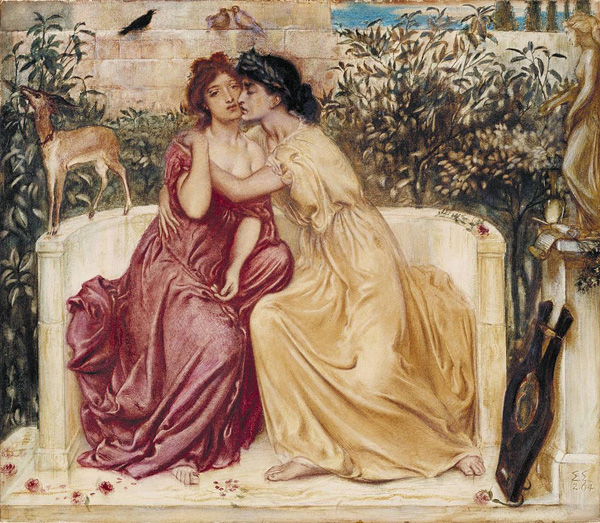
Sappho and Erinna in a Garden at Mytilene by Simeon Solomon (1864).
English Pre-Raphaelite painter and Jewish gay man Simeon Solomon (1840 – 1905) depicted the lesbian poet Sappho in his painting Sappho and Erinna in a Garden at Mytelene (1864). French painter Gustave Coubert (1819 – 1877) painted Le Sommeil/ The Sleepers (1866). – No doubt Coubert was painting his heterosexual male fantasy of two nude women together in this painting. A few years later the painting was banned from being exhibited.
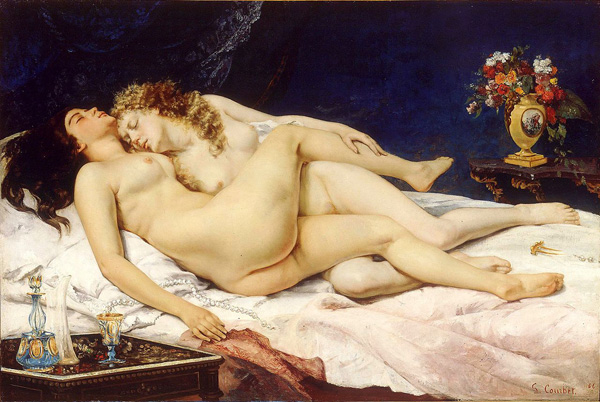
Le Sommeil by Gustave Coubert (1866).
Post-Impressionist painter Henri de Toulouse-Lautrec also painted lesbians. He has made a number of realistic paintings of friendships and intimate relationships between women such as In Bed: The Kiss (1892) and Les deux amies (1895).
The voyeuristic male gaze and the male artists’ depictions of lesbianism turned lesbians into erotic objects of desire for men. This trend of producing titillating lesbian imagery for male consumption has bloomed to the extent that ‘lesbian art’ today is a euphemism for erotic female nudes and pornographic “lesbian” imagery created by men for male consumption.
The 1895 trials of British author Oscar Wilde helped shape the emergent identity of the homosexual as both a criminal offender and a bohemian artist. There was extensive press coverage of the trials and Oscar Wilde was charged with ‘gross indecency’, an act which only could be perpetrated by ‘male persons’; women could not commit the crime of gross indecency, much less be convicted for it, as the legal system in the UK failed to imagine the very possibility of lesbian sexuality in the 19th century.
The Lesbian ‘Selfies’ And Other Gender-bending Experiments
With photography becoming the new popular media at the beginning of the of the 20th century a number of lesbian photographers started making staged photographs of themselves, the first lesbian ‘selfies’ were created and snapshots are taken of friends and lovers. These photos offer a remarkable glimpse into the photographers’ private lives, gender-bending experiments and art projects.
Marie Høeg (1866 – 1949)
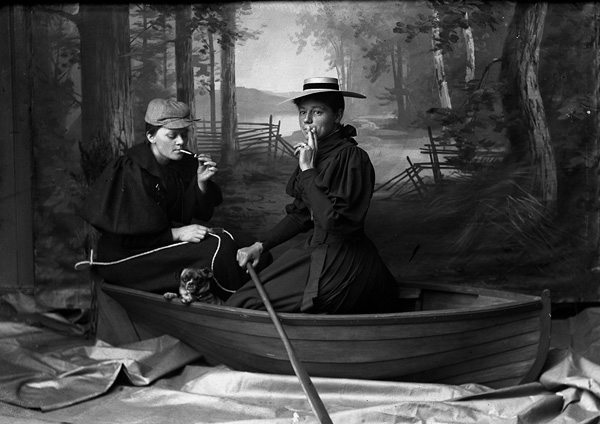
Self-portrait smoking by Marie Høeg (left) and her partner Bolette Berg (1895 – 1903). It was considered unladylike to smoke around 1900, but women saw cigarettes as a sign of freedom. A sign that they were their own person.
Photographers Marie Høeg (1866 – 1949) and Bolette Berg operated a commercial studio in the Norwegian town of Horten from 1895 to 1903. Marie Høeg was a suffragette and she used their studio as a meeting place for fellow activists and women interested in the suffrage movement and women’s right to vote. In the 1980s a box of the partners’ glass plate negatives marked “private” was discovered on a farm where they once lived, revealing their private lives and lesbian ‘selfies’.
Claude Cahun (1894 – 1954)
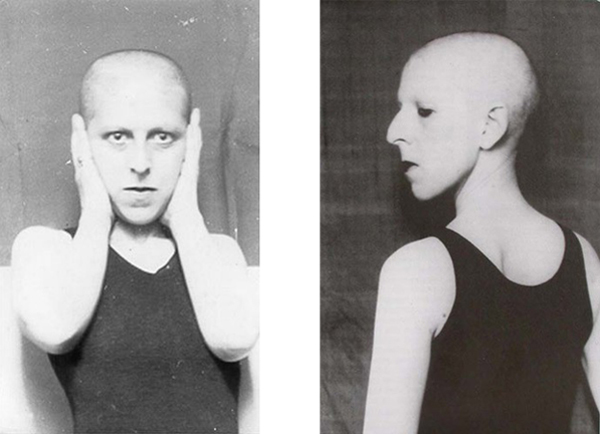
Self-portraits by Claude Cahun.
In around 1919 Parisian artist and writer Lucy Renee Mathilde Schwob (1894 – 1954), age 25, became Claude Cahun. She was living with her life partner and artistic collaborator Marcel Moore, whose given name was Suzanne Malherbe. Claude was one of the few women surrealists in André Breton’s French surrealist circle. Her oeuvre consists of a body of photographs with shaven-headed androgyne, cloaked and masked, cross-dressed self-portraits as different characters and a number of publications and unpublished writings. Claude Cahun’s work in the 1920s and 1930s was almost forgotten until the late 1980s, and much of her and Suzanne’s work was destroyed by the Nazis, who requisitioned their home on Jersey. What remains is mostly in the collection of Jersey Heritage Trust.
In the 1990s Claude Cahun achieved international posthumous fame for her ‘queer’ photographs which are still very popular and often on display at museums around the world.
‘In Russia, women poets and artists were also experimenting with gender at the turn of the twentieth century. Cross-voicing in poetry and cross-dressing in public characterized the (self-) representation of some of the more radical creative women of the time. The destabilization of gender typified not only their art, but also the way they exhibited their bodies, and it informed their subjectivity in a totalizing way.’ – Alexandra Exeter
Elizaveta Sergeyevna Kruglikova (1865 – 1941)
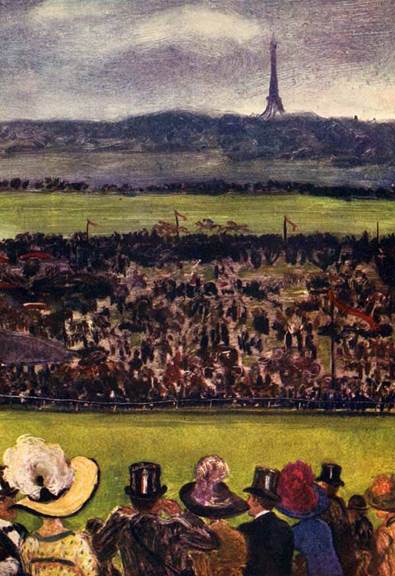
Horse Race by Elizaveta Kruglikova (1914).
Russian artist Elizaveta Sergeyevna Kruglikova (Russian: Елизавета Сергеевна Кругликова; 1865 – 1941) studied painting in Paris at the beginning of the 20th century. She painted the Horse Race in 1914 just before World War I. She has also made a remarkable series of black silhouette portraits and silhouettes of street life in Paris. Elizaveta Kruglikova was a lesbian who invested her creativity in the act of unveiling her gender ambiguity. Her masculine style included participation in male sports, such as long-distance cycling and mountain climbing. The artist and her girlfriend, Mademoiselle Sellier cycled from Paris to Brittany around 1905, wearing special cyclist trousers (the cycle bloomers) which were still considered to be rather shocking in provincial France.
The Salons And Their Hostesses
Lesbian artists (couples) would entertain artists and other people from the cultural elite in a ‘salon’ in their homes. This was a popular way of getting together with like-minded people. Today some of them are famous for their literary salons and informal networks of homosexual artists and other creatives.
‘Nathalie Barney held early gatherings of the salon at her house in Neuilly. The entertainment included poetry readings and theatricals (in which Colette sometimes performed). Mata Hari performed a dance once, riding into the garden as Lady Godiva on a white horse harnessed with turquoise cloisonné. The play ‘Equivoque’ may have led Natalie Barney to leave Neuilly in 1909. According to a contemporary newspaper article, her landlord objected to her holding an outdoor performance of a play about Sappho, which he felt “followed nature too closely”.’ – Wikipedia
Natalie Clifford Barney (1876 – 1972)
Natalie Clifford Barney (1876 – 1972) was an American playwright, poet, novelist and expatriate who lived in Paris from 1900 until her death. Natalie held a salon for more than 60 years, first at her home in Neuilly and from ca 1909 at her home in Paris’ Left Bank. In this period she brought together writers and artists from around the world. She was openly lesbian and began publishing love poems to women under her own name as early as 1900; the title of her first collection of poems was Quelques Portraits-Sonnets de Femmes (Some Portrait-Sonnets of Women). Her longest relationship, 50 years, was with the American painter Romaine Brooks, whom she met around 1914.
Romaine Brooks (1874 – 1970)
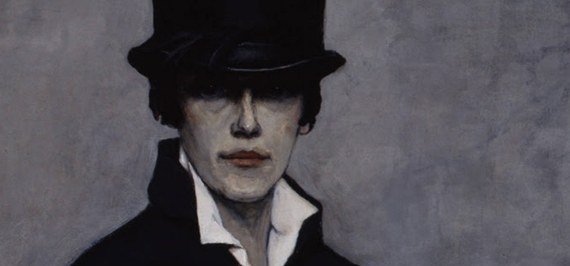
Detail from Self-portrait by Romaine Brooks (1923).
American painter Romaine Brooks (1874 – 1970) and partner of Romaine Brooks lived most of her life in Paris, where she was a leading figure of an avant-garde counterculture of upper-class Europeans and American expatriates, many of whom were creative, bohemian and homosexual. She is famous for her images of women in androgynous or masculine dress, including her self-portrait of 1923, where she is in a masculine coat, wearing a high hat. Romaine Brooks’s exploration of gender and sexuality in many of her portraits led to a post-hum interest in her work in the 1980s and a new biography which includes details about her life as a lesbian was published in 2016.
Nan Hudson (1869 – 1957) & Ethel Sands (1873 – 1962)
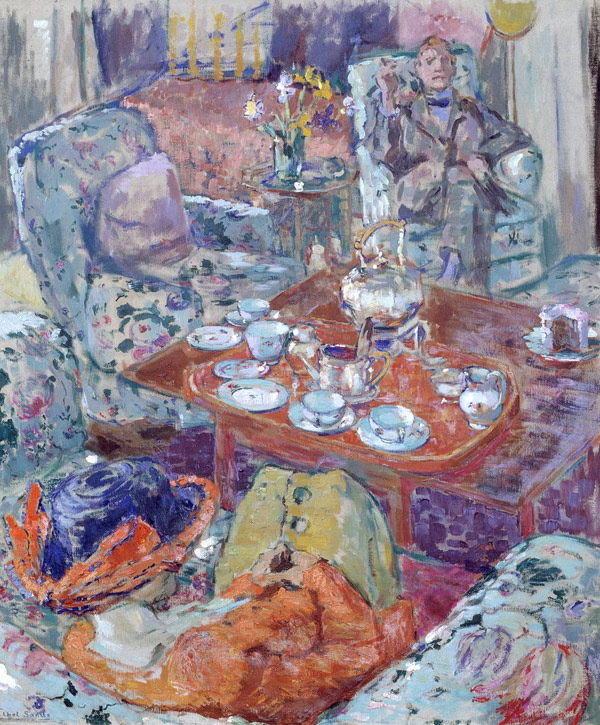
Tea with Sickert by Ethel Sands (1911 – 1912).
American artist Anna Hope ‘Nan’ Hudson (1869 – 1957) became a young woman of independent means in 1892. She had the freedom to choose her own path in life and she moved to Paris to study art. There she met fellow American art student Ethel Sands (1873 – 1962), who became her life partner. They lived and worked in Europe for the rest of their lives, dividing their time between France and England.
Due to Ethel’s family’s wealth, she collected art and was a patron, but she is best known as a hostess for the cultural elite in her homes in England and in Nan’s house in France.
Gertrude Stein (1874 – 1946)
Gertrude Stein (1874 – 1946) was an American novelist, poet, playwright, art collector and Jewish lesbian. She moved to Paris in 1903 and made France her new home. She held a salon in Paris, where the leading figures of modernism in literature and art would meet. Many of her guests were homosexual or bisexual artists such as her painter Marie Laurencin. Gertrude’s early publications include Q.E.D. (Quod Erat Demonstrandum) (1903), about a lesbian romantic affair involving several of Stein’s female friends. In 1933, she published a “memoir” of her Paris years: The Autobiography of Alice B. Toklas, written in the voice of her partner, Alice B. Toklas. The book was followed by an enormously successful American book tour in 1934-35, where she gave lectures about herself, the Parisian avant-garde and modern art, and had taken tea with Eleanor Roosevelt in the White House.
Marie Laurencin (1883 – 1956)
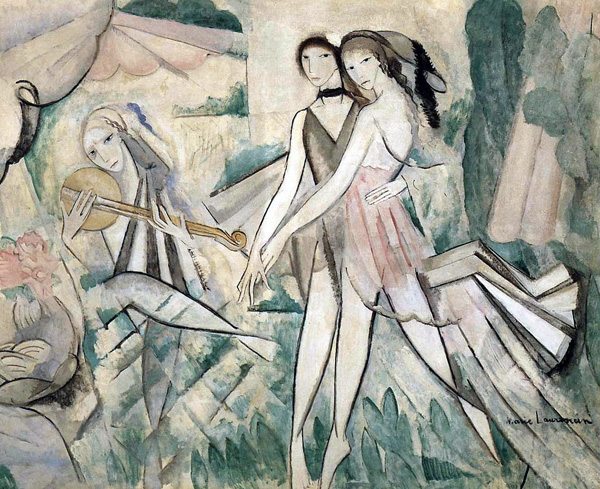
Le Bal élégant, La Danse à la campagne by Marie Laurencin (1913).
French painter and bisexual woman Marie Laurencin (1883 – 1956) was an important figure in the Parisian avant-garde as one of the few female Cubist painters; she presented her portraits of women at exhibitions in France and the USA before World War I and was a frequent guest in Gertrude Stein’s salon. Her work lies outside the bounds of Cubist norms in her pursuit of a specifically feminine aesthetic by her use of pastel colours and curved lines, evoking an enchanted world. She also painted portraits of Parisian celebrities and produced theatre sets, in particular for the Ballets Russes.
In 1983 the Musée Marie Laurencin opened in Nagano Prefecture, Japan. The museum is home to more than 500 of her works and an archive.
The New Woman of the 1920s and 1930s
Women had joined the labour force during World War I. After the war they were the centre of a new popular culture, becoming ‘The Modern Woman’ as we know her in the 1920s i.e. the ‘Girl’ with bobbed hair or the ‘Garçonne’ with an ‘Eaton bob’, the shortest of the “bobbed” hairstyles wearing cloche hats.
Clare ‘Tony’ Atwood (1866 – 1962)
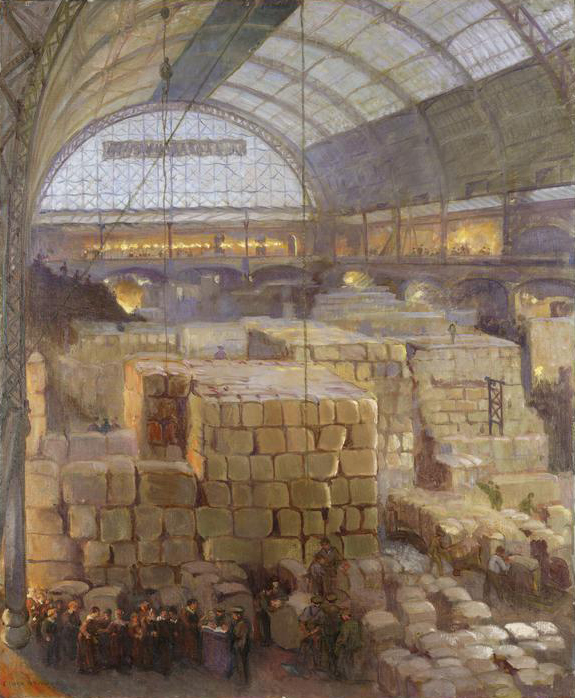
Olympia in War Time: Royal Army Clothing Depot by Clare ‘Tony’ Atwood (1918).
Clare ‘Tony’ Atwood (1866 – 1962) was a British painter. During World War I and later, in 1920, she was commissioned to paint “war paintings”. Clare lived in a female ménage a trois in Kent with the dramatist Christabel Marshall aka Christopher Marie St John and the actress, theatre director, producer and costume designer Edith Craig from 1916 until Edith’s death in 1947.
Tamara de Lempicka (1898? – 1980)
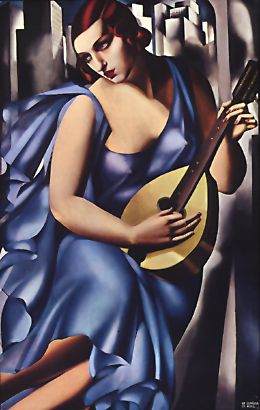
“The Musician” by Tamara de Lempicka (1929).
Tamara de Lempicka (1898? – 1980) was from a wealthy Polish family. In 1918 she, her husband and their child moved to Paris, where she started studying painting. She developed her own unique style in the 1920s, painting her erotic female nudes and portraits of modern liberated women of the elite in Europe. Arts writer Elizabeth Ashburn writes: ‘Her first lesbian affair was with a wealthy redhead, probably Ira Perrot, who modelled for her and she took her to Italy, paying all expenses. In Italy, the artist discovered the paintings of Botticelli and Messina and attended lesbian parties. At one such gathering, she arranged food tastefully on the body of a nude woman and then slowly ate “her midnight meal.” In her trips to Italy, she became part of a circle that included Violette Trefusis (the lover of Vita Sackville-West) and Colette. These women appreciated bisexual behaviour and had numerous affairs with individuals of both sexes. In 1933, de Lempicka began an affair with a singer at the Boîte de Nuit, Suzy Solidar, a friendship that lasted several decades.’
The Great Depression had little effect on Tamara; in the early 1930s, she was painting King Alfonso XIII of Spain and Queen Elizabeth of Greece on her way into high society. Museums also began to collect her works and her new social status in high society was cemented when she married her second husband.
Berenice Abbott (1898 – 1991)
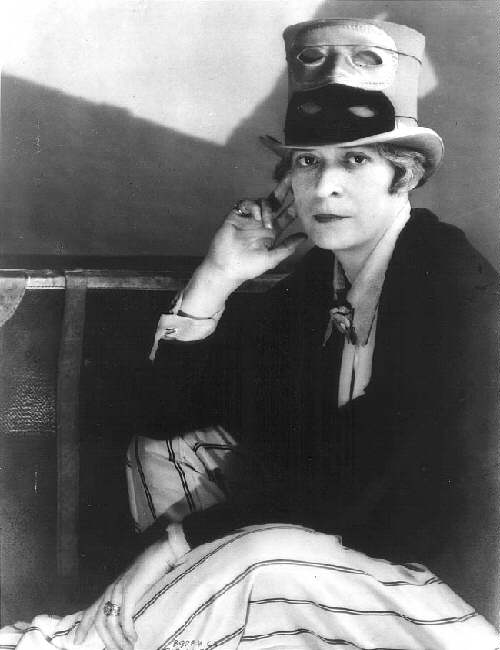
Janet Flanner by Berenice Abbott. American journalist and lesbian Janet Flanner before a costume ball.
Berenice Abbott (1898 – 1991) went to Paris in 1921 to study art. Photographer Man Ray hired her as a darkroom assistant in 1923. She fell in love with photography and ran her own portrait studio from 1926 – 1929. She is famous for her portraits of the intelligentsia in Paris; to sit and be photographed by Berenice Abbott (and Man Ray) meant you were ‘rated as somebody’ in Paris in the 1920s.
The turning point in Berenice’s career came in 1929 when she returned to New York and began a five-year endeavour called Changing New York, documenting the new architecture and the urban development of the city. In 1935 she moved into a Greenwich Village loft with the art critic Elizabeth McCausland, with whom she lived until Elizabeth’s death in 1965. Berenice Abbott was a closeted lesbian all her life and had a very successful career as a photographer in the USA after her years in Paris.
Photographs of British author Radclyffe Hall and her partner Lady Una Elena Troubridge appeared widely in the popular press in the 1920s, asserting Radclyffe’s identity as a lesbian and a public figure. Radclyffe Hall’s novel ‘The Well of Loneliness’ (1929) is said to have helped define the lesbian ‘butch’ and ‘femme’ identities. A British court judged the book obscene because it defended “unnatural practices between women”. However, in spite of the initial legal issues, the book was met within the UK and the US ‘The Well of Loneliness’ gained international recognition enough to be included in public libraries in the US and other countries. It was probably the only piece of lesbian literature any young lesbian had ever heard about until the end of the 1950s.
Marjorie ‘Marlow’ Moss (1889 – 1958)
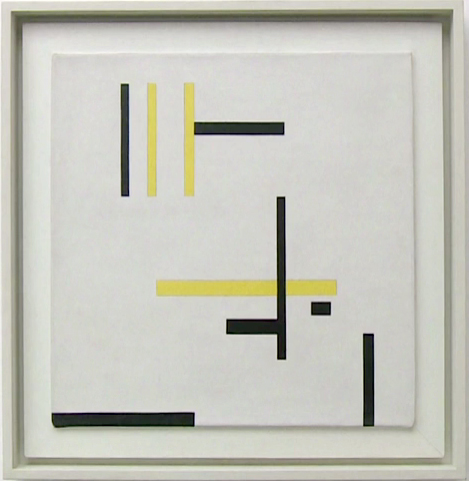
An early work by Marlow Moss.
Marjorie Jewel ‘Marlow’ Moss (1889 – 1958) was one of Britain’s most significant Constructivist artists. Against the wishes of her family she chose to pursue an artistic career, studying at the St John’s Wood School of Art in 1916–17, then at the Slade School of Fine Art in London. She changed her forename from Marjorie to “Marlow” and adopted a masculine appearance in around 1919. Her oeuvre spanned painting, sculpture and reliefs. Her paintings are highly abstract compositions with grids and coloured rectangles (which can easily be mistaken for works by Dutch artist Piet Mondrian). In the 1930s she was based in Paris where she apprenticed herself to Fernand Lége. There she made her all-white reliefs of wood, rope and string. She met her lifelong partner, the Dutch writer Antoinette ‘Nettie’ Hendrika Nijhoff-Wind in Paris. At the beginning of World War II Marlow left France to live near Lamorna Cove in Cornwall, studying architecture at the Penzance School of Art. After World War II her architectural studies led her to develop new sculptural and relief works.
Hannah ‘Gluck’ Gluckstein (1895 – 1978)
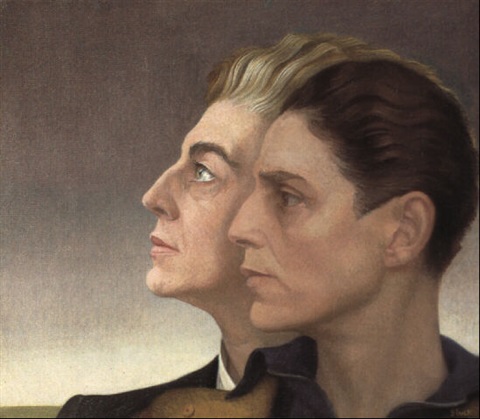
Medallion by Gluck (1937); a double portrait of Gluck (right) with Nesta Obermer.
Hannah ‘Gluck’ Gluckstein (1895 – 1978) alias “Peyter Gluck” was born to a wealthy Jewish family in London. In the 1920s she decided to become an artist, insisted on being known only as “Gluck”, dressed in male attire, and lived openly with women throughout her life. Gluck painted landscapes, floral pieces and portraits of her friends, family and lovers. She was in a relationship with Constance Spry from 1932 – 1936. One of Gluck’s best-known paintings, Medallion (1937), is a dual portrait of herself and her partner, Nesta Obermer.
The creative trend in the Weimar Republic was called ‘Neue Sachlichkeit’ (the New Objectivity) where the artist could describe the world as ‘objectively’ as they saw it. In the 1930s ‘Neue Sachlichkeit’ art of the 1920s was labelled ‘Entartete kunst’ (Degenerate art) by Hitler and German artists were banned from exhibiting and selling their works.
Jeanne Mammen (1890 – 1976)
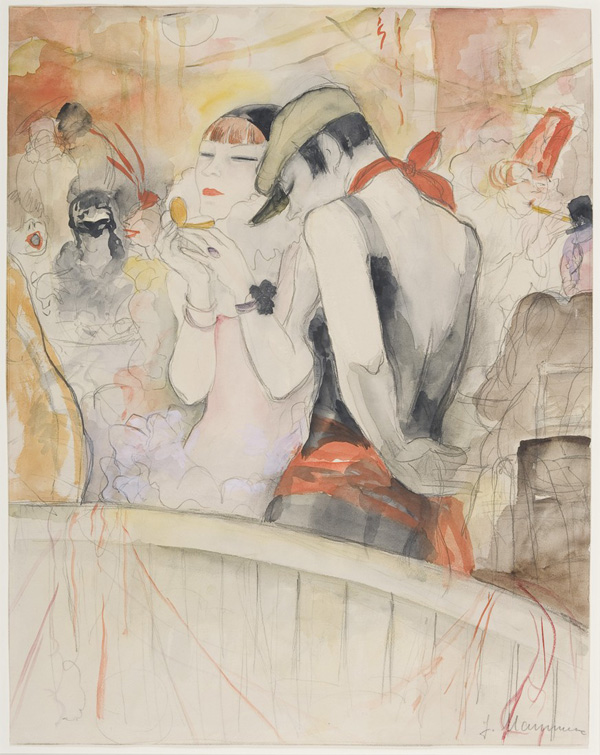
Watercolor by Jeanne Mammen.
Jeanne Mammen (1890 – 1976) was born in Berlin and grew up in France after 1900. She began her training as a painter and graphic artist in Paris, which she later continued in Brussels and Rome. Her family had to flee from France at the outbreak of World War I and as of 1915 Jeanne Mammen was again living in Berlin. In Berlin, she made a number of sketches and watercolours of ‘bachelor girls’ and butch-femme couples from a lesbian nightclub in Berlin. Her first exhibition at the Galerie Gurlitt, in 1930, was universally acclaimed by Berlin art critics and took its inspiration from the streets, featuring her images of strong, confident women and the lesbian community of the late 1920s. A few years later the Nazi authorities denounced her motifs and subjects as “Jewish”, and banned her lithographs for Les Chansons de Bilitis in 1933. In the 1930s the Nazis shut down most of the journals she had worked for, and she refused to work for those that complied with their cultural policies. This stopped her from publishing and exhibiting her work, but it did not mean the end of her artmaking. After World War II, she began exhibiting her work again, by then her work had become abstract. In the 1950s she adopted a new style, combining thick layers of oil paint with a few fine marks on the surface. Her first retrospective exhibition opened a year before her death.
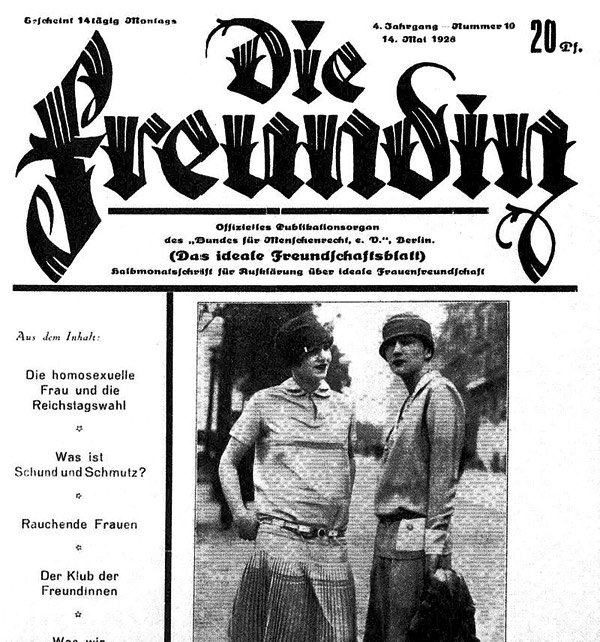
Cover of Die Freundin (the Girlfriend). The theme of the issue was „Die homosexuelle Frau und die Reichstagswahl“ (The homosexual woman and the national election), May 1928.
Berlin was going through a sexual revolution in the early 1920s, fashion made women’s legs and arms visible for the first time ever in the streets and cafes of the city; and a new visibility for lesbians emerged with publications of lesbian magazines such as Die Freundin (first issue published in 1925) and Frauenlibe/Garçonne.
The ‘lesbian scene’ of the late 1920s and early 1930s attracted the attention of artists, authors, photographers and (male) doctors. French photographer Brasasï photographed lesbians at the lesbian bar, ‘Le Monocle’ in Paris, in 1932. Magnus Hirschfeld, a German physician, who had proposed a ‘third gender’, made mannish women, effeminate men and cross-dressers in Berlin the objects of his clinical studies and political activism as a campaigner of civil rights for gay men, lesbians, women and illegitimate children.
Magnus Hirschfeld’s work and the theses of sexologists such as Krafft-Ebbing and Havelock Ellis were instrumental in the establishment of the medical model of homosexuality, defining it as a form of ‘natural biological variation’ rather than a ‘religious’ question about sinful behaviour. And it inspired the post-World War II American sexology’s interest in the homoerotic and homosexuality.
Hannah Höch (1889 – 1978)
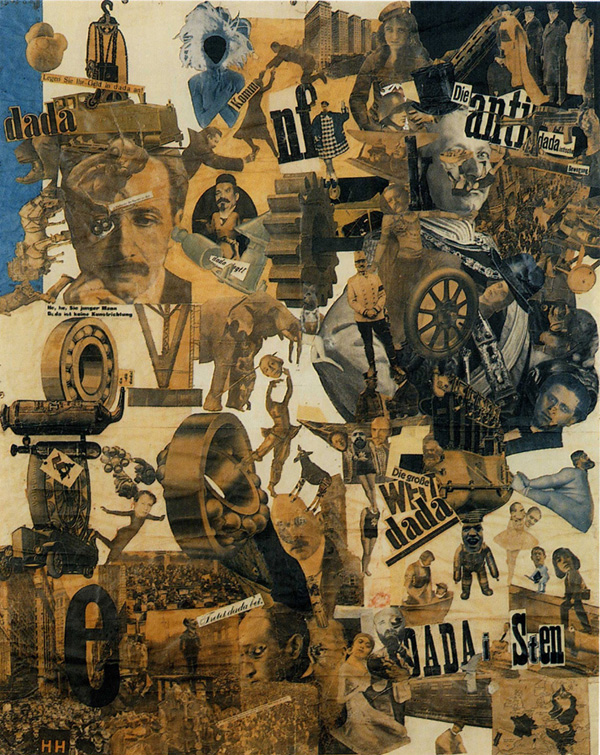
Cut with the Kitchen Knife through the Beer-Belly of the Weimar Republic (1919), a photomontage by Hannah Höch.
Surrealist artist, member of the Berlin DADA movement and bisexual woman Hannah Höch (1889 – 1978) is famous for her photomontages with photos pulled from newspapers and arts magazines, some of which present a very humoristic view on genders, gender-bending, the male gaze and politics in the Weimar Republic. She considered herself a part of the women’s movement in the 1920s and was critical of the way women were portrayed in the media, the hypocrisy of the Berlin Dada group (the members of which were predominantly male artists) and German society as a whole. In 1926 she met Dutch writer and linguist Mathilda ‘Til’ Brugman. They started a relationship which was to last for nine years.
Gisèle Freund (1908 – 2000)
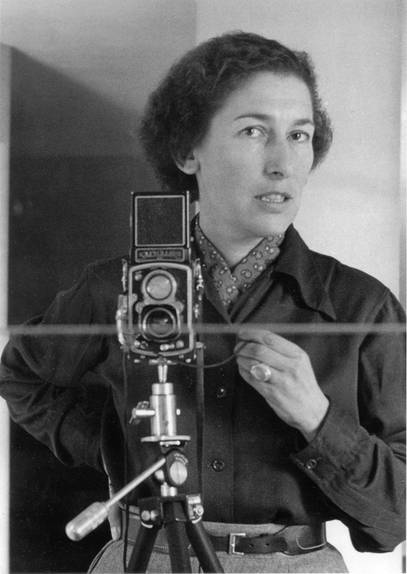
Self-portrait by Gisèle Freund.
Gisèle Freund (1908 – 2000) was a Jewish German-born photographer-photojournalist, famous for her documentary photography. She fled from Nazi Germany to Paris in 1933. Once in Paris, Freund continued to work on her art and began studying at the Sorbonne, where she earned her PhD. in 1936. Among her assignments as a photographer in France was a series of images on the effects of the Depression in England for Life Magazine. In Paris, she became friends of Sylvia Beach and Adrienne Monnier. In 1935 Adrienne arranged a marriage of convenience for Gisèle with Pierre Blum so that Gisèle could obtain a visa to remain in France legally. However, later Gisèle had to flee from France and with the help of friends, she escaped to Argentina. In 1947 Gisèle Freund was the first woman to sign a contract with Magnum Photos agency (as a Latin America contributor), but by 1954 she was declared persona non grata by the U.S. Government at the height of the Red Scare for her socialist views, and Robert Capa forced her to break ties with Magnum Photos.
Anita Clara Rée (1885 – 1933)
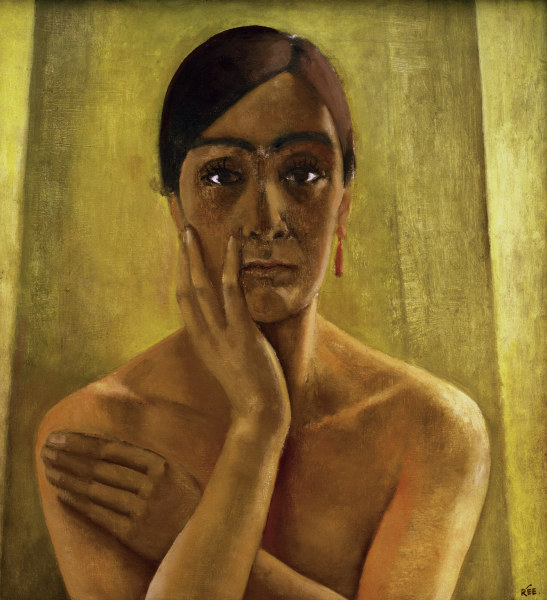
Self-portrait by Anita Rée (ca. 1929).
Anita Clara Rée (1885 – 1933) was a German avant-garde painter during the Weimar Republic. She was born into an old Jewish family in Hamburg. She studied art in Hamburg and in Paris, and from around 1914 Anita Rée gained recognition as a portrait painter. Life was hard on Anita. She committed suicide in 1933. German historians name her reasons partly as a result of having been subjected to hostility from various groups and harassment by anti-semitic forces, partly due to disappointments on the personal level, the latter indicating that she probably was a lesbian.
Gertrude Sandmann (1893 – 1981)
Gertrude Sandmann (1893 – 1981) was a German painter. In 1913 Gertrude started to study at the art school of the Berlin Association of Women Artists under Martin Brandenburg. As a native Berlin Jewess, she experienced not only World War I but also the agony of World War II and the Holocaust. She belonged to the about 1,700 Jews who survived World War II hiding in Berlin. After a fictitious suicide, she went underground in 1942 helped by her Aryan girlfriend, Hedwig Koslowski, hiding in Hedwig’s apartment in Schöneberg. Later, as a “Verfolgte des Naziregimes” (a victim of the Nazists), she was given an apartment in the centre of Berlin. Here she lived together with her second partner Tamara Streck. Gertrude Sandmann worked as an artist until her death in 1981. She was an open lesbian and has done much for the recognition of homosexuality in Germany.
Tove Jansson (1914 – 2001)
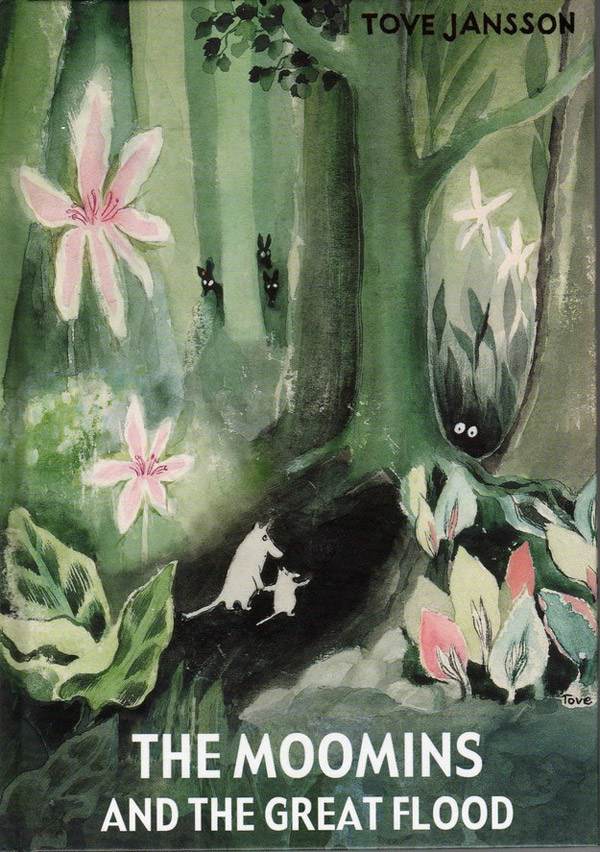
Cover by Tove Jansson
Finnish author, illustrator and comic strip author Tove Marika Jansson (1914 – 2001) is famous for her children’s books about the Moomin. Tove Jansson wrote and illustrated her first Moomin book, The Moomins and the Great Flood, in 1945 during World War II. She said later that the war had depressed her and that she had wanted to write something naïve and innocent. Tove was born in Helsinki into a Swedish-speaking family. Her parents were artistic and her siblings became artists too. She had studied art in Stockholm, Helsinki and Paris from 1930 – 1938, and she opened her first solo exhibition in Finland in 1943. In 1956 she met Ida Helmi Tuulikki Pietilä a graphic artist who became her lifelong partner. Tuulikki Pietilä inspired Tove to create the energetic figure ‘Tooticky’ in her Moomin books. Tove is said to have considered her careers as an author and a painter to be of equal importance. She painted her whole life, changing style from the classical impressionism of her youth to the highly abstract modernist style of her later years. The Moomin Museum in Tampere, Finland is dedicated to Tove Jansson’s work on the Moomins.
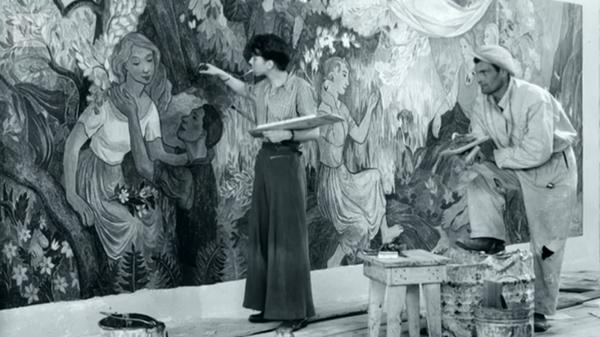
Tove Jansson painted a fresco in 1947.